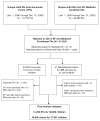Agreement between structured checklists and Medicaid claims for preventive dental visits in primary care medical offices
- PMID: 20573644
- PMCID: PMC5101046
- DOI: 10.1177/1460458210364036
Agreement between structured checklists and Medicaid claims for preventive dental visits in primary care medical offices
Abstract
For program evaluation purposes, the feasibility of matching Medicaid claims with physician-completed structured checklists (encounter forms, EFs) was assessed in a pediatric office-based preventive dental program. We examined agreement on visits (weighted kappa) and predictors of a match between EFs and claims (multinomial logit model with practice-level clustering). In total, 34,171 matches occurred between 41,252 EFs and 40,909 claims, representing 82.8 per cent of EFs and 83.5 per cent of claims. Agreement on visits was 56 per cent (weighted kappa = 0.66). Pediatric practices provided the majority of visits (82.4%) and matches. Increasing age of child and residence in same county as the medical practice increased the likelihood of a match. Structured checklists can be combined with claims to better assess provision of preventive dental services in pediatric primary care. However, future research should examine strategies to improve the completion of structured checklists by primary care providers if data beyond claims are to be used for program evaluation.
Conflict of interest statement
The authors declare no competing interests.
Figures



Similar articles
-
Training pediatric health care providers in prevention of dental decay: results from a randomized controlled trial.BMC Health Serv Res. 2007 Nov 2;7:176. doi: 10.1186/1472-6963-7-176. BMC Health Serv Res. 2007. PMID: 17980021 Free PMC article. Clinical Trial.
-
Follow-up preventive dental visits for Medicaid-enrolled children in the medical office.J Public Health Dent. 2008 Summer;68(3):131-8. doi: 10.1111/j.1752-7325.2007.00055.x. J Public Health Dent. 2008. PMID: 18179471 Clinical Trial.
-
Examining continuity of care for Medicaid-enrolled children receiving oral health services in medical offices.Matern Child Health J. 2015 Jan;19(1):196-203. doi: 10.1007/s10995-014-1510-3. Matern Child Health J. 2015. PMID: 24802261 Free PMC article.
-
Preventive Services by Medical and Dental Providers and Treatment Outcomes.J Dent Res. 2014 Jul;93(7):633-8. doi: 10.1177/0022034514536731. Epub 2014 Jun 2. J Dent Res. 2014. PMID: 24891593 Free PMC article.
-
Disparities in oral health and access to care: findings of national surveys.Ambul Pediatr. 2002 Mar-Apr;2(2 Suppl):141-7. doi: 10.1367/1539-4409(2002)002<0141:diohaa>2.0.co;2. Ambul Pediatr. 2002. PMID: 11950385 Review.
Cited by
-
Accuracy of record linkage software in merging dental administrative data sets.J Public Health Dent. 2013 Spring;73(2):89-93. doi: 10.1111/j.1752-7325.2012.00343.x. Epub 2012 May 11. J Public Health Dent. 2013. PMID: 22574821 Free PMC article.
References
-
- Cooper GS, Schultz L, Simpkins J, Lafata JE. The utility of administrative data for measuring adherence to cancer surveillance care guidelines. Medical Care. 2007;45(1):66–72. - PubMed
-
- Leake JL, Werneck RI. The use of administrative databases to assess oral health care. Journal of Public Health Dentistry. 2005;65(1):21–35. - PubMed
-
- Warren JL, Harlan LC, Fahey A, Virnig BA, Freeman JL, Klabunde CN, et al. Utility of the SEER–Medicare data to identify chemotherapy use. Medical Care. 2002;40(8 suppl):IV-55–IV-61. - PubMed
-
- Bullano MF, Kamat S, Willey VJ, Barlas S, Watson DJ, Brenneman SK. Agreement between administrative claims and the medical record in identifying patients with a diagnosis of hypertension. Medical Care. 2006;44(5):486–90. - PubMed
Publication types
MeSH terms
Grants and funding
LinkOut - more resources
Full Text Sources
Medical

